 Facebook
Facebook
 X
X
 Instagram
Instagram
 TikTok
TikTok
 Youtube
Youtube

It used to be the Titleist golf ball factory. Now, instead of churning out thousands of non-recyclable plastic golf balls every year, the Escondido site is home to a recycling solution: the first anaerobic digester in San Diego County. The new facility will convert food waste into burnable bio gas, diverting thousands of tons of organic matter from the landfill to power EDCO disposal company’s fleet of trucks. Soon, many residential EDCO customers will be able to throw food scraps in the green bin along with yard waste. Meat, fish, bones, oils, and dairy — all a no-no for backyard composters — are included in the commingling. Soiled napkins, paper towels, biodegradable paper, and coffee grounds (with filters) can go in, too.
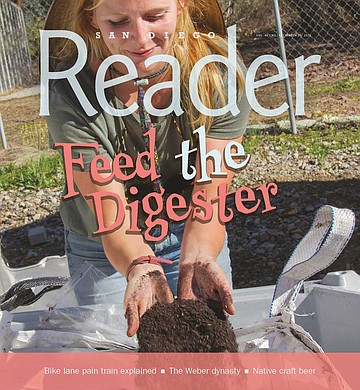
“The bugs are in the tanks,” says EDCO general manager Jim Ambroso in December. It takes a few months for the “bugs” — bacteria, actually — to create conditions ripe for adding rotting organic matter. And it’s those bugs, along with the absence of oxygen, which make it possible to break down stuff that would ruin an outdoor compost pile. Soon the massive turbines inside the subway-station-sized tanks will be slowly churning 92,000 tons (per year) of San Diego’s discarded organic matter while it ferments at 131 degrees. The digestate, as the slurry is called, undergoes refinement on site to prepare for burning as bio gas. Fertilizer is a byproduct. A $3 million CalRecycle grant helped fund the new digester; Ambroso declined to reveal the cost of construction.
Ambroso dresses in slacks and polos and doesn’t look like the typical “go team enviro” type. But he can rattle off statistics from memory and cite the multiple California laws that regulate solid waste.
EDCO’s digester is an integral part of the county’s efforts to comply with Senate Bill 1383, which targets 50 percent organic waste reduction by 2020 and 75 percent by 2025. That means to divert (or eliminate) 332,000 of the 500,000 tons of food waste San Diegans send to landfills each year. Fifteen percent of San Diego’s waste stream is food, and consumers create 43 percent of that, Ambroso says. “When I told my wife we would be separating food scraps at home, she was skeptical. She was worried about bugs and rodents in our kitchen. I explained to her that I couldn’t go around asking customers to do it if I wasn’t doing it in my own house.”
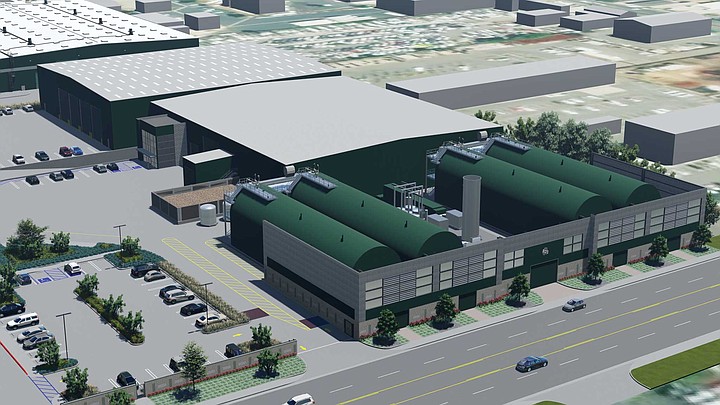
Residential single-family EDCO customers will get a kitchen caddy sometime this year, along with education materials on food recycling. The Ambrosos tested theirs for several months in 2020.
“No ants, no roaches, no rodents,” Ambroso told the Poway-based audience of a webinar. “The caddy is sealed. You can put it in the fridge or freezer, or ‘wrap the scrap’ in newspaper or other biodegradable paper, and put that in the freezer until trash day. Make a food waste burrito.”
The new anaerobic digester is one of about 100 worldwide, including 20 here in California. Another is planned for southern San Diego County, though an exact location hasn’t been announced. “I can’t say much more, but the permits are in place,” says Ambroso.
When burned, bio gas produced by anaerobic digestion emits less carbon than petroleum-based fuel and displaces more greenhouse gas emissions than it produces — “carbon-negative,” Ambroso says. That makes the digester a better option than allowing food to rot in the landfill and release methane into the atmosphere. However, “it’s not an end-all,” says Ambroso’s colleague Bob Hill, a former Navy man whose voice is loud enough to hear over the sorting machinery at Escondido Disposal’s recycling facility, next to the digester. “We need to have all different avenues for dealing with this stuff.”
As a greenhouse gas, methane is 84 times more potent than carbon dioxide, say scientists at Nasa Earth Observatory. Organic waste in landfills is a major producer of methane. Nationwide, the US Department of Agriculture estimates that about 30-40 percent of all food sold at the consumer level goes to waste. Furthermore, the FDA says that wasted food in the United States adds up to $161 billion annually. In California, organics — food, biodegradable paper, and plant clippings — make up 34 percent of garbage in landfills, according to the California Department of Resources Recyling and Recovery. In 2025, the agency projects, that amount will reach 26 million tons per year. The goal of state laws is to cut it to 5.75 million tons.
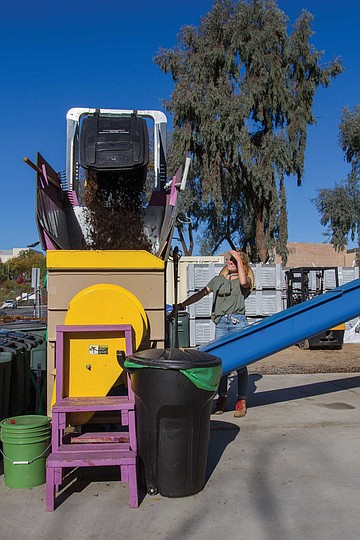
“The amount of land devoted to growing wasted food is equivalent to the state of Pennsylvania,” says Emily Nelson, education manager at I Love A Clean San Diego. The number one method for mitigating methane from food waste is source reduction. For consumers, that means buying less food, eating leftovers, and using up all that produce you purchase when optimistically planning to eat more veggies. (Some sources claim a family of four could save as much as $1500 a year by eliminating food waste.)
But it’s more complicated for businesses. AB 1826 mandates commercial organic waste recycling for businesses that produce more than two cubic yards of solid waste per week. They must separate food waste on site and pay for pick-up, self-haul to a composter or recycler, or donate edible excess. The law requires Ambroso to offer customized collection solutions for businesses to help feed commercial food waste to his pet digester.
Composting is another avenue San Diego residents and businesses are taking to deal with food waste. The state allows residents to have a small compost pile at home. But inconsistent regulations and waste hauling agreements throughout San Diego County complicate “what should be the simple act” of composting food scraps, says Naomi Wentworth of the Compost Group, a North County-based organization which “pick[s] up your food and paper waste and compost[s] it locally for you into a healthy soil.” Many cities in San Diego prohibit private composters from charging a fee for collection of food scraps even when the city’s contracted hauler does not offer compost service. Many cities place restrictions on composting of food scraps not generated onsite. That list includes Carlsbad, Poway, Oceanside, San Marcos, Coronado, National City, La Mesa, Lemon Grove, Santee, El Cajon, and Solana Beach.
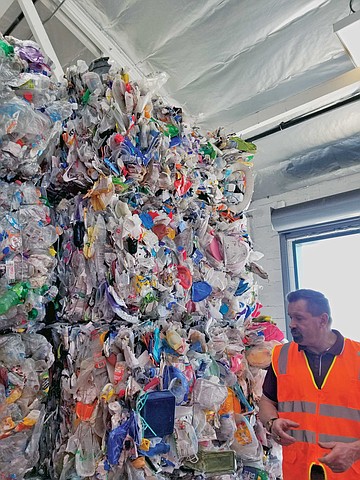
Del Mar is doing something different: championing the Compost Group to sub-contract with goliath Waste Management for a commercial pilot program. Businesses will pay Wentworth’s company $13-$19 to pick up food scraps in 32-gallon bins and haul them to her composting facility. She can process 1200 tons per year.
“It’s not costing Del Mar anything, it’s not costing Waste Management anything,” Wentworth says. “We’re basically begging cities to be allowed to collect their organic waste.” Wentworth, an engineer by training, built an industrial-scale compost tumbler on a piece of Cal State San Marcos’s land. The steel drum turns gently and pumps air into the tank to produce “moist, fluffy, earthy-smelling” soil amendment that she applies to the university’s landscaping. Since February 2020 she’s been feeding it scraps from the campus dining halls.
“It’s right next to the dorms. It’s enclosed, so there’s no odor, no seagulls, no rodents,” Wentworth says affectionately of her composter, which cost $250,000 to build. It also eats scraps from restaurants, as well as larger corporate campuses and hotels around North County. Las Olas in Cardiff contributed 5194 pounds of food in one month.
The city of San Diego does allow fee-based food scraps hauling by third-party contractors, along with small-scale, fee-based composting. Since the early 2000s, the city has operated large-scale composting at Miramar Greenery, next to the landfill, diverting 40,000 tons of residential and organic waste annually. In 2001, Marine Corps Recruit Depot became the first participant; Petco Park joined in 2005 and contributed 132 tons of food waste in one year. The commercial food waste recycling program picks up scraps from over 80 commercial entities including Blind Lady Alehouse, Snooze A.M. Eatery, Stone Brewery, Francis Parker School, Sharp Hospitals, SeaWorld, the Zoo, and the airport.
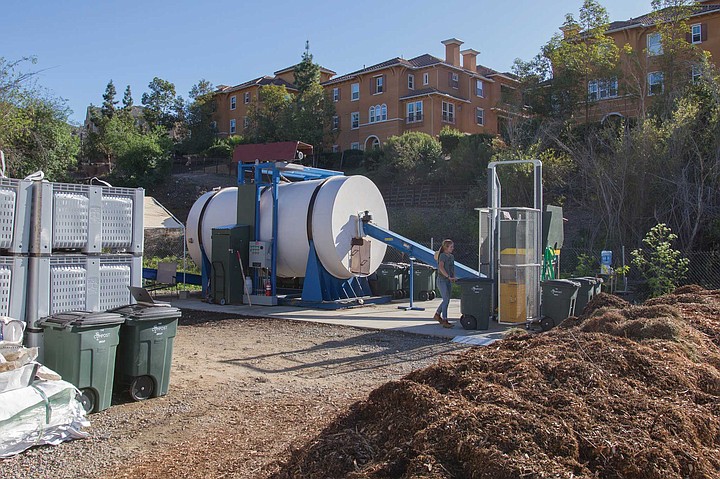
A third set of community composting and food scraps hauling regulations applies to unincorporated parts of the county. Fallbrook, Ramona, and Lakeside currently have contracts with EDCO (or sister company Escondido Disposal) to begin commingling residential food waste for the digester.
Confused by this labyrinth of local laws and waste hauling agreements? That’s where Food2Soil compost hub manager Alyssa Brodsky comes in. Founded in 2015 with ten buckets of food scraps from Ironside Fish & Oyster in Little Italy, composting collective Food2Soil now operates a network of dropoff sites around the county — from urban farms to back alleys — with over 500 residential customers. They also manage on-site composting for corporate cafeteria scraps at General Atomics, and for the dining halls at Mesa College. So far Food2Soil has diverted 318 tons of food waste from the landfill. “A drop in the bucket,” Brodsky says.
Brodsky gets her hands dirty at Ocean View Growing Grounds in south San Diego. Residents pay $5-15 to drop off a bucket of food scraps, and they can take home “all you can sift” finished compost in return. Businesses pay $18 for weekly pick up of a 32-gallon cart. Food2Soil even offers a program for “soil farmers” to earn income by maintaining a neighborhood compost pile.
She learned how to “cook” compost for maximum agricultural effect in Madagascar when she was in the Peace Corps. “Where I grew up in Illinois, we always had a compost pile.” With bright blue eyes, strawberry blond hair, and freckles, she wields a pitchfork in a most wholesome way. Brodsky is working to expand community composting without violating any local laws.
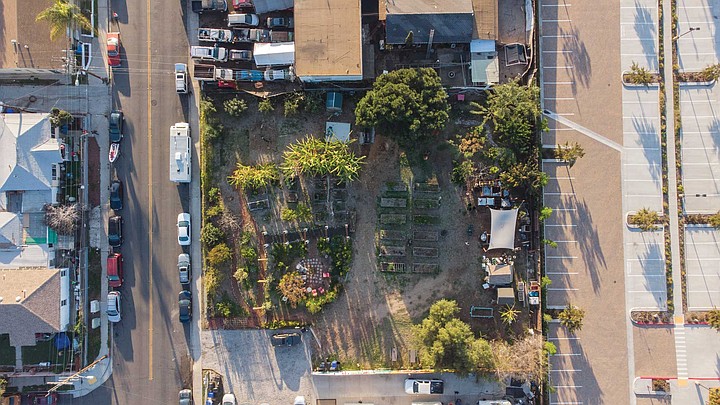
But hotels, hospitals, and big institutions — the county’s “large generators,” as Bob Hill called them — need more than scrap collection and composting to comply with SB 1383. They need reduction and diversion strategies, and they need Geertje Grootenhuis, food waste program director at San Diego Food System Alliance. Born in the Netherlands, Grootenhuis moved with her family to San Diego at age four. She double majored at UC Berkeley, in business administration/society and environment, “two areas that seemed as different as night and day.” She landed a data science job in the Bay Area after graduation, but it didn’t feel right to her. She moved back to San Diego and got a job making smoothies at a healthy cafe, while exploring a career in the sustainable food systems sector. Her college project — a social enterprise model to streamline commercial food waste in a profitable way — landed her a job with the San Diego Food System Alliance three years ago.
Grootenhuis recruited 15 of the biggest commercial food waste generators to track waste with Leanpath software for the Smart Kitchens San Diego pilot program, funded by CalRecycle. Kitchen staff at Viejas Casino and Resort, Fairmont Grand Del Mar, UC San Diego Health, and other big-name participants discovered that, collectively, they tossed over 40,000 pounds of veggies and almost $40,000 worth of beef. And much more. Trimmings such as onion skins and banana peels made up 31 percent of waste. Leftovers, unserved food, and surplus was 55 percent. Chef Ryan at the Hilton Bayfront discovered that pastries from the catering operation were regularly left over in large quantities, Grootenhuis says, so he utilized the excess to create a bread pudding recipe for the hotel’s restaurant.
“It was surprisingly hard,” Grootenhuis admitted with a big smile, “to give away subsidized food waste tracking software. I heard from chefs over and over, ‘We don’t have food waste in our kitchen.’” It’s not a pleasant reality for a chef to acknowledge. And changing behavior in the kitchen takes staff time and training. Still, over two years, kitchens reduced their food waste by 42 percent, diverted 336,502 pounds of food waste, and provided 170,000 meals to folks experiencing food insecurity in San Diego.
Senate Bill 1383 calls for 20 percent donation of edible surplus by 2025. In partnership with San Diego Food Bank, Grootenhuis helped commercial scale kitchens navigate safety regulations (and labor limitations) to get surplus prepared food onto peoples’ plates — and found partners willing to do the hauling. Sous chef Robert Lippman at Viejas Casino and Resort hooked up with Heaven’s Windows executive Angela Kretschmar, bringing meals to two Spring Valley distribution locations.
“‘I go to the Viejas buffet with my husband on special occasions,’” Kretschmar told Grootenhuis, “and now I get to share that good comfort food with our clients.’”
Says chef Lippman, “The fear of food poisoning and legal action has always deterred chefs from giving leftover food to the needy. Since partnering with the San Diego Food System Alliance, we have confidently given over our buffet items to the less fortunate. Instead of filling trash cans we are filling hungry stomachs.”
Food scraps are on the menu at restaurants Wrench & Rodent and The Plot, in Oceanside. For owners Jessica and Davin Waite, zero waste, “nose-to-tail” dining is business as usual. Carrot tops go into a pesto. Banana peels get caramelized and simmered in a pork adobada broth, wrapped in a corn tortilla and dressed with fresh salsa, street taco style.
“What’s unique and special about San Diego,” says Brodsky, “is that there are lots of organizations that are aware of food waste and lots of collaboration.” Food banks in San Diego divert millions of pounds of surplus edible food from grocery stores. In 2019, San Diego gleaning organizations redistributed 249 tons of edible produce from farms and backyards that would otherwise go to a landfill. The airport alone sent 400 tons of food waste to the Greenery in 2019.
So with all these efforts in place, how are we doing on food waste? The state didn’t meet its 50 percent diversion goal by 2020, which triggered the reduction of the commercial waste threshold from four cubic yards to two. Food waste recycling requirements from Senate Bill 1383 kick in January 1, 2022 for commercial entities and single- and multi-family residences.
Despite imminent deadlines, San Diego is still figuring it out. The city’s 2015 Zero Waste Plan had a “wait and see” element to it: “If the construction of necessary facilities to achieve the goals do not materialize, evaluation of other options will be proposed. Other options would include implementation of exclusive franchises that require the franchisee to develop appropriate infrastructure or development of a City-operated facility for example.”
The city has a waiting list for commercial food waste pick-up service; hundreds of businesses still need to find a way to comply. So far residents haven’t heard of a city plan for residential food scrap collection — though two thirds of city dwellers do have yard waste pick-up.
In June 2020 the county’s integrated waste management plan says, “If the state goals are to be achieved, expansions and/or additional facilities will be needed in the region. Anaerobic digestion facilities are being proposed.”
Financial stakes are high. Starting in 2022, SB 1383 allows for enforcement on jurisdictions that commit major food waste violations — such as failure to support an edible food donation program. Fines could run up to $10,000 per day per violation.


It used to be the Titleist golf ball factory. Now, instead of churning out thousands of non-recyclable plastic golf balls every year, the Escondido site is home to a recycling solution: the first anaerobic digester in San Diego County. The new facility will convert food waste into burnable bio gas, diverting thousands of tons of organic matter from the landfill to power EDCO disposal company’s fleet of trucks. Soon, many residential EDCO customers will be able to throw food scraps in the green bin along with yard waste. Meat, fish, bones, oils, and dairy — all a no-no for backyard composters — are included in the commingling. Soiled napkins, paper towels, biodegradable paper, and coffee grounds (with filters) can go in, too.

“The bugs are in the tanks,” says EDCO general manager Jim Ambroso in December. It takes a few months for the “bugs” — bacteria, actually — to create conditions ripe for adding rotting organic matter. And it’s those bugs, along with the absence of oxygen, which make it possible to break down stuff that would ruin an outdoor compost pile. Soon the massive turbines inside the subway-station-sized tanks will be slowly churning 92,000 tons (per year) of San Diego’s discarded organic matter while it ferments at 131 degrees. The digestate, as the slurry is called, undergoes refinement on site to prepare for burning as bio gas. Fertilizer is a byproduct. A $3 million CalRecycle grant helped fund the new digester; Ambroso declined to reveal the cost of construction.
Ambroso dresses in slacks and polos and doesn’t look like the typical “go team enviro” type. But he can rattle off statistics from memory and cite the multiple California laws that regulate solid waste.
EDCO’s digester is an integral part of the county’s efforts to comply with Senate Bill 1383, which targets 50 percent organic waste reduction by 2020 and 75 percent by 2025. That means to divert (or eliminate) 332,000 of the 500,000 tons of food waste San Diegans send to landfills each year. Fifteen percent of San Diego’s waste stream is food, and consumers create 43 percent of that, Ambroso says. “When I told my wife we would be separating food scraps at home, she was skeptical. She was worried about bugs and rodents in our kitchen. I explained to her that I couldn’t go around asking customers to do it if I wasn’t doing it in my own house.”

Residential single-family EDCO customers will get a kitchen caddy sometime this year, along with education materials on food recycling. The Ambrosos tested theirs for several months in 2020.
“No ants, no roaches, no rodents,” Ambroso told the Poway-based audience of a webinar. “The caddy is sealed. You can put it in the fridge or freezer, or ‘wrap the scrap’ in newspaper or other biodegradable paper, and put that in the freezer until trash day. Make a food waste burrito.”
The new anaerobic digester is one of about 100 worldwide, including 20 here in California. Another is planned for southern San Diego County, though an exact location hasn’t been announced. “I can’t say much more, but the permits are in place,” says Ambroso.
When burned, bio gas produced by anaerobic digestion emits less carbon than petroleum-based fuel and displaces more greenhouse gas emissions than it produces — “carbon-negative,” Ambroso says. That makes the digester a better option than allowing food to rot in the landfill and release methane into the atmosphere. However, “it’s not an end-all,” says Ambroso’s colleague Bob Hill, a former Navy man whose voice is loud enough to hear over the sorting machinery at Escondido Disposal’s recycling facility, next to the digester. “We need to have all different avenues for dealing with this stuff.”
As a greenhouse gas, methane is 84 times more potent than carbon dioxide, say scientists at Nasa Earth Observatory. Organic waste in landfills is a major producer of methane. Nationwide, the US Department of Agriculture estimates that about 30-40 percent of all food sold at the consumer level goes to waste. Furthermore, the FDA says that wasted food in the United States adds up to $161 billion annually. In California, organics — food, biodegradable paper, and plant clippings — make up 34 percent of garbage in landfills, according to the California Department of Resources Recyling and Recovery. In 2025, the agency projects, that amount will reach 26 million tons per year. The goal of state laws is to cut it to 5.75 million tons.

“The amount of land devoted to growing wasted food is equivalent to the state of Pennsylvania,” says Emily Nelson, education manager at I Love A Clean San Diego. The number one method for mitigating methane from food waste is source reduction. For consumers, that means buying less food, eating leftovers, and using up all that produce you purchase when optimistically planning to eat more veggies. (Some sources claim a family of four could save as much as $1500 a year by eliminating food waste.)
But it’s more complicated for businesses. AB 1826 mandates commercial organic waste recycling for businesses that produce more than two cubic yards of solid waste per week. They must separate food waste on site and pay for pick-up, self-haul to a composter or recycler, or donate edible excess. The law requires Ambroso to offer customized collection solutions for businesses to help feed commercial food waste to his pet digester.
Composting is another avenue San Diego residents and businesses are taking to deal with food waste. The state allows residents to have a small compost pile at home. But inconsistent regulations and waste hauling agreements throughout San Diego County complicate “what should be the simple act” of composting food scraps, says Naomi Wentworth of the Compost Group, a North County-based organization which “pick[s] up your food and paper waste and compost[s] it locally for you into a healthy soil.” Many cities in San Diego prohibit private composters from charging a fee for collection of food scraps even when the city’s contracted hauler does not offer compost service. Many cities place restrictions on composting of food scraps not generated onsite. That list includes Carlsbad, Poway, Oceanside, San Marcos, Coronado, National City, La Mesa, Lemon Grove, Santee, El Cajon, and Solana Beach.

Del Mar is doing something different: championing the Compost Group to sub-contract with goliath Waste Management for a commercial pilot program. Businesses will pay Wentworth’s company $13-$19 to pick up food scraps in 32-gallon bins and haul them to her composting facility. She can process 1200 tons per year.
“It’s not costing Del Mar anything, it’s not costing Waste Management anything,” Wentworth says. “We’re basically begging cities to be allowed to collect their organic waste.” Wentworth, an engineer by training, built an industrial-scale compost tumbler on a piece of Cal State San Marcos’s land. The steel drum turns gently and pumps air into the tank to produce “moist, fluffy, earthy-smelling” soil amendment that she applies to the university’s landscaping. Since February 2020 she’s been feeding it scraps from the campus dining halls.
“It’s right next to the dorms. It’s enclosed, so there’s no odor, no seagulls, no rodents,” Wentworth says affectionately of her composter, which cost $250,000 to build. It also eats scraps from restaurants, as well as larger corporate campuses and hotels around North County. Las Olas in Cardiff contributed 5194 pounds of food in one month.
The city of San Diego does allow fee-based food scraps hauling by third-party contractors, along with small-scale, fee-based composting. Since the early 2000s, the city has operated large-scale composting at Miramar Greenery, next to the landfill, diverting 40,000 tons of residential and organic waste annually. In 2001, Marine Corps Recruit Depot became the first participant; Petco Park joined in 2005 and contributed 132 tons of food waste in one year. The commercial food waste recycling program picks up scraps from over 80 commercial entities including Blind Lady Alehouse, Snooze A.M. Eatery, Stone Brewery, Francis Parker School, Sharp Hospitals, SeaWorld, the Zoo, and the airport.

A third set of community composting and food scraps hauling regulations applies to unincorporated parts of the county. Fallbrook, Ramona, and Lakeside currently have contracts with EDCO (or sister company Escondido Disposal) to begin commingling residential food waste for the digester.
Confused by this labyrinth of local laws and waste hauling agreements? That’s where Food2Soil compost hub manager Alyssa Brodsky comes in. Founded in 2015 with ten buckets of food scraps from Ironside Fish & Oyster in Little Italy, composting collective Food2Soil now operates a network of dropoff sites around the county — from urban farms to back alleys — with over 500 residential customers. They also manage on-site composting for corporate cafeteria scraps at General Atomics, and for the dining halls at Mesa College. So far Food2Soil has diverted 318 tons of food waste from the landfill. “A drop in the bucket,” Brodsky says.
Brodsky gets her hands dirty at Ocean View Growing Grounds in south San Diego. Residents pay $5-15 to drop off a bucket of food scraps, and they can take home “all you can sift” finished compost in return. Businesses pay $18 for weekly pick up of a 32-gallon cart. Food2Soil even offers a program for “soil farmers” to earn income by maintaining a neighborhood compost pile.
She learned how to “cook” compost for maximum agricultural effect in Madagascar when she was in the Peace Corps. “Where I grew up in Illinois, we always had a compost pile.” With bright blue eyes, strawberry blond hair, and freckles, she wields a pitchfork in a most wholesome way. Brodsky is working to expand community composting without violating any local laws.

But hotels, hospitals, and big institutions — the county’s “large generators,” as Bob Hill called them — need more than scrap collection and composting to comply with SB 1383. They need reduction and diversion strategies, and they need Geertje Grootenhuis, food waste program director at San Diego Food System Alliance. Born in the Netherlands, Grootenhuis moved with her family to San Diego at age four. She double majored at UC Berkeley, in business administration/society and environment, “two areas that seemed as different as night and day.” She landed a data science job in the Bay Area after graduation, but it didn’t feel right to her. She moved back to San Diego and got a job making smoothies at a healthy cafe, while exploring a career in the sustainable food systems sector. Her college project — a social enterprise model to streamline commercial food waste in a profitable way — landed her a job with the San Diego Food System Alliance three years ago.
Grootenhuis recruited 15 of the biggest commercial food waste generators to track waste with Leanpath software for the Smart Kitchens San Diego pilot program, funded by CalRecycle. Kitchen staff at Viejas Casino and Resort, Fairmont Grand Del Mar, UC San Diego Health, and other big-name participants discovered that, collectively, they tossed over 40,000 pounds of veggies and almost $40,000 worth of beef. And much more. Trimmings such as onion skins and banana peels made up 31 percent of waste. Leftovers, unserved food, and surplus was 55 percent. Chef Ryan at the Hilton Bayfront discovered that pastries from the catering operation were regularly left over in large quantities, Grootenhuis says, so he utilized the excess to create a bread pudding recipe for the hotel’s restaurant.
“It was surprisingly hard,” Grootenhuis admitted with a big smile, “to give away subsidized food waste tracking software. I heard from chefs over and over, ‘We don’t have food waste in our kitchen.’” It’s not a pleasant reality for a chef to acknowledge. And changing behavior in the kitchen takes staff time and training. Still, over two years, kitchens reduced their food waste by 42 percent, diverted 336,502 pounds of food waste, and provided 170,000 meals to folks experiencing food insecurity in San Diego.
Senate Bill 1383 calls for 20 percent donation of edible surplus by 2025. In partnership with San Diego Food Bank, Grootenhuis helped commercial scale kitchens navigate safety regulations (and labor limitations) to get surplus prepared food onto peoples’ plates — and found partners willing to do the hauling. Sous chef Robert Lippman at Viejas Casino and Resort hooked up with Heaven’s Windows executive Angela Kretschmar, bringing meals to two Spring Valley distribution locations.
“‘I go to the Viejas buffet with my husband on special occasions,’” Kretschmar told Grootenhuis, “and now I get to share that good comfort food with our clients.’”
Says chef Lippman, “The fear of food poisoning and legal action has always deterred chefs from giving leftover food to the needy. Since partnering with the San Diego Food System Alliance, we have confidently given over our buffet items to the less fortunate. Instead of filling trash cans we are filling hungry stomachs.”
Food scraps are on the menu at restaurants Wrench & Rodent and The Plot, in Oceanside. For owners Jessica and Davin Waite, zero waste, “nose-to-tail” dining is business as usual. Carrot tops go into a pesto. Banana peels get caramelized and simmered in a pork adobada broth, wrapped in a corn tortilla and dressed with fresh salsa, street taco style.
“What’s unique and special about San Diego,” says Brodsky, “is that there are lots of organizations that are aware of food waste and lots of collaboration.” Food banks in San Diego divert millions of pounds of surplus edible food from grocery stores. In 2019, San Diego gleaning organizations redistributed 249 tons of edible produce from farms and backyards that would otherwise go to a landfill. The airport alone sent 400 tons of food waste to the Greenery in 2019.
So with all these efforts in place, how are we doing on food waste? The state didn’t meet its 50 percent diversion goal by 2020, which triggered the reduction of the commercial waste threshold from four cubic yards to two. Food waste recycling requirements from Senate Bill 1383 kick in January 1, 2022 for commercial entities and single- and multi-family residences.
Despite imminent deadlines, San Diego is still figuring it out. The city’s 2015 Zero Waste Plan had a “wait and see” element to it: “If the construction of necessary facilities to achieve the goals do not materialize, evaluation of other options will be proposed. Other options would include implementation of exclusive franchises that require the franchisee to develop appropriate infrastructure or development of a City-operated facility for example.”
The city has a waiting list for commercial food waste pick-up service; hundreds of businesses still need to find a way to comply. So far residents haven’t heard of a city plan for residential food scrap collection — though two thirds of city dwellers do have yard waste pick-up.
In June 2020 the county’s integrated waste management plan says, “If the state goals are to be achieved, expansions and/or additional facilities will be needed in the region. Anaerobic digestion facilities are being proposed.”
Financial stakes are high. Starting in 2022, SB 1383 allows for enforcement on jurisdictions that commit major food waste violations — such as failure to support an edible food donation program. Fines could run up to $10,000 per day per violation.
Comments